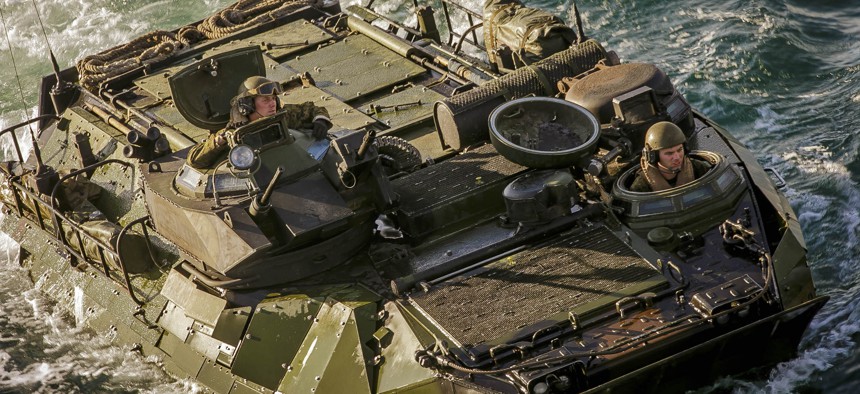BY ELIZABETH HOWE
 The amphibious assault vehicle mishap that killed eight Marines and a sailor in July 2020 has spurred many “lessons learned” that leaders say will prevent anything so “tragic” from happening again. But along with improved safety measures and redundancies, the accident also showed the Marine Corps that it may no longer be honed for amphibious operations, Marine Corps leaders told Congress on Monday.
The amphibious assault vehicle mishap that killed eight Marines and a sailor in July 2020 has spurred many “lessons learned” that leaders say will prevent anything so “tragic” from happening again. But along with improved safety measures and redundancies, the accident also showed the Marine Corps that it may no longer be honed for amphibious operations, Marine Corps leaders told Congress on Monday.Almost the entire fleet of AAVs—not just those involved in the fatal training accident—failed to meet operational standards, Maj. Gen. Gregg Olson, Marine Corps staff director explained. When the 13 vehicles were delivered to the 15th Marine Expeditionary Unit in April 2020, 12 were not operational. But they were deemed ready for landborne operations after months of repairs by 15th MEU mechanics, and by July, the AAVs had achieved “what we thought” was waterborne capabilities, Olson said.
However, the vehicles did not meet the standards required for waterborne operations, as became clear after the accident. More than 54 percent of the AAVs in the fleet did not meet watertight integrity standards, an investigation revealed.
“What we found in our subsequent inspections after a safety of use message came up on the 31st of July was that we had a problem across the fleet with our watertight integrity,” Olson said.
The leader identified as partly at fault for deploying the vehicles, Maj. Gen. Robert Castellvi, has been suspended. Castellvi is the current Marine Corps inspector general but was the commanding general of 1st Marine Division at the time of the accident.
While the Navy has not returned to waterborne AAV operations since the mishap, the Marine Corps has. And Gen. Gary Thomas, assistant Marine Corps commandant, told the House Armed Services Subcommittee on Readiness on Monday that the vehicles themselves will remain in the Marine Corps’s fleet until 2026, despite their poor performance.
“These are old vehicles, but they are broadly well understood,” Thomas said. “I assure you, we will fully resource any requirement to keep these operational.”
Beyond the questionable maintenance of the AAVs, prior investigations have revealed that personnel involved in the accident were also not prepared for the training exercise. Many of the Marines had not completed training designed to teach them how to escape from a submerged vehicle. Swim and water qualifications were not current. When the AAV began to sink on July 30, the lack of adequate training coupled with the vehicle’s maintenance shortcomings proved fatal.
Testimony revealed that after decades in the Middle East, neither the Marine Corps’s vehicles nor its troops are prepared for waterborne operations.
“It may have been that the twenty years of landborne operations have caused us to lose some of our amphibious edge,” Olson told Congress on Monday.
That amphibious edge is a major factor in the Marine Corps of the future—where maritime operations will reign. Berger’s Force Design 2030 report claims the Corps is trudging ahead on dramatically transforming into a maritime force capable of multi-domain operations, fully equipped with amphibious ships and alternative platforms. Berger’s vision for the future of the Marines is to “create a true naval expeditionary stand-in-force and force-in-readiness.”
And last year’s AAV mishap has been a powerful indicator to lawmakers and the public that the Marine Corps has a lot of work to do to achieve this future.
No comments:
Post a Comment